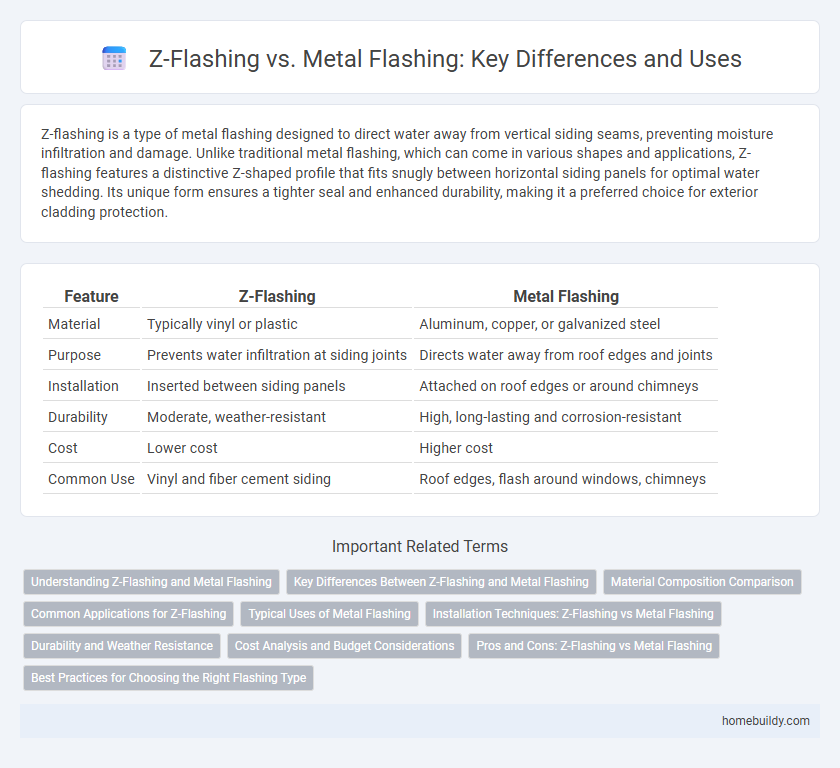Z-flashing is a type of metal flashing designed to direct water away from vertical siding seams, preventing moisture infiltration and damage. Unlike traditional metal flashing, which can come in various shapes and applications, Z-flashing features a distinctive Z-shaped profile that fits snugly between horizontal siding panels for optimal water shedding. Its unique form ensures a tighter seal and enhanced durability, making it a preferred choice for exterior cladding protection.
Table of Comparison
| Feature | Z-Flashing | Metal Flashing |
|---|---|---|
| Material | Typically vinyl or plastic | Aluminum, copper, or galvanized steel |
| Purpose | Prevents water infiltration at siding joints | Directs water away from roof edges and joints |
| Installation | Inserted between siding panels | Attached on roof edges or around chimneys |
| Durability | Moderate, weather-resistant | High, long-lasting and corrosion-resistant |
| Cost | Lower cost | Higher cost |
| Common Use | Vinyl and fiber cement siding | Roof edges, flash around windows, chimneys |
Understanding Z-Flashing and Metal Flashing
Z-flashing is a metal flashing shaped like the letter "Z," designed to divert water away from wall joints and prevent moisture infiltration in building exteriors. Metal flashing, including Z-flashing, is used to protect structures by directing water away from vulnerable areas such as windows, doors, and siding seams. Understanding the specific applications and installation techniques of Z-flashing versus other metal flashing types is essential for effective water management and long-term durability in construction.
Key Differences Between Z-Flashing and Metal Flashing
Z-flashing is a specific type of metal flashing designed with a Z-shaped profile to efficiently direct water away from horizontal joints, preventing water infiltration in exterior siding applications. Unlike general metal flashing, which can vary in shape and function, Z-flashing specifically targets the vulnerable areas between siding panels or windows, offering enhanced protection against moisture damage. The key difference lies in the shape and targeted use, where Z-flashing provides a strategic barrier at siding joints, while metal flashing encompasses a broader category including drip edges, step flashings, and other configurations for various roofing and wall applications.
Material Composition Comparison
Z-flashing is typically made from galvanized steel, aluminum, or copper, offering flexibility and corrosion resistance ideal for siding applications. Metal flashing materials vary widely, including lead, zinc, and stainless steel, each providing different durability and weatherproofing qualities. The choice between Z-flashing and other metal flashings depends on the specific material composition, which influences longevity, cost, and ease of installation.
Common Applications for Z-Flashing
Z-flashing is commonly used in vertical siding installations, window and door openings, and where siding meets masonry or stucco to prevent water infiltration. Its design efficiently directs water away from vulnerable joints, enhancing building envelope protection. Unlike metal flashing, Z-flashing is primarily installed in wood and vinyl siding applications requiring flexibility and corrosion resistance.
Typical Uses of Metal Flashing
Metal flashing is commonly used in roofing, window installations, and around chimneys to prevent water infiltration and protect structural elements from moisture damage. Its durability and weather resistance make it ideal for areas exposed to heavy rain, ice, and snow, ensuring long-term protection against leaks. Typical materials include aluminum, copper, and galvanized steel, chosen for their strength and corrosion resistance.
Installation Techniques: Z-Flashing vs Metal Flashing
Z-flashing installation involves securing the Z-shaped metal strip over horizontal wall joints, ensuring water is directed away from vulnerable seams and preventing moisture intrusion. Metal flashing installation can vary but often requires bending and shaping metal pieces to fit roof intersections and protrusions, with sealed edges to form a watertight barrier. Z-flashing is generally easier to install on vertical joints due to its preformed shape, while metal flashing demands precise custom fitting for complex roof geometries.
Durability and Weather Resistance
Z-flashing outperforms metal flashing in durability by using corrosion-resistant materials that extend its lifespan against moisture and UV exposure. It provides superior weather resistance, effectively directing water away from vulnerable siding joints and preventing leaks. Unlike traditional metal flashing, Z-flashing maintains flexibility and strength under temperature fluctuations, ensuring long-term protection.
Cost Analysis and Budget Considerations
Z-flashing typically offers a more cost-effective solution compared to metal flashing due to lower material and installation expenses, making it ideal for budget-conscious projects. Metal flashing, while more durable and long-lasting, often incurs higher upfront costs related to premium materials like aluminum or copper and specialized labor. Careful budget analysis should weigh the initial investment against long-term maintenance and replacement expenses to determine the most economical choice for a specific application.
Pros and Cons: Z-Flashing vs Metal Flashing
Z-flashing offers superior water diversion due to its angled design, making it highly effective at preventing moisture infiltration around windows and siding joints, but it is typically made of vinyl, which can be less durable than metal flashing. Metal flashing, usually made from aluminum or galvanized steel, provides excellent durability and resistance to weather damage, though it requires professional installation to avoid corrosion and improper sealing. While Z-flashing is easier to install and often more cost-effective, metal flashing delivers longer-lasting protection in harsh climates, balancing installation complexity with enhanced longevity.
Best Practices for Choosing the Right Flashing Type
Z-flashing is preferred for horizontal siding joints due to its easy installation and effective water diversion, whereas metal flashing offers superior durability and corrosion resistance for roof edges and chimneys. Selecting the right flashing type depends on material compatibility, environmental exposure, and the specific application area to enhance weatherproofing. Employing corrosion-resistant metals like aluminum or galvanized steel in metal flashing and ensuring proper overlap in Z-flashing installation are key best practices for long-lasting protection.
Z-flashing vs metal flashing Infographic

 homebuildy.com
homebuildy.com